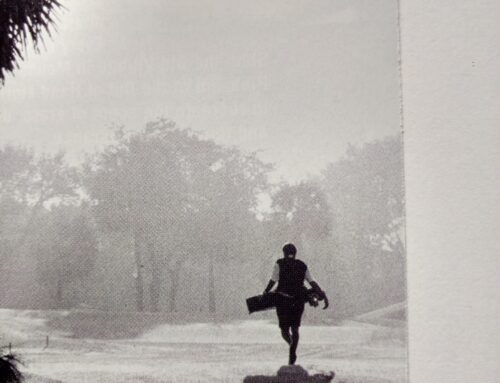Share the love
Golf Datatech – Overview and Analysis
Evolution of Custom Fitting Golf Equipment in the United States
Golf club fitting became the norm for most Serious Golfers when the reality of data driven swing analysis intersected with manufacturers and retailers recognizing that golf clubs could perform in a superior manner when the primary components were fine tuned to perform optimally for the individual golfer. Additionally, club adapters that allowed heads and shafts to be assembled in a matter of seconds for fitting purposes, made the entire process substantially more effective. The big club brands changed their manufacturing processes to speed up delivery of special-order product, Off Course Specialty stores used simulator/launch monitors to offer but not push fitting, while Custom Fitting Specialists opened retail operations dedicated to the best possible fit.
The club business hasn’t looked the same since. And custom fit golf clubs helped provide the impetus for pricing to move significantly higher, however as happens in most industries, when there is a significant shift in the foundation of an industry, there are unforeseen outcomes, and in golf clubs it may lead to a much longer purchase cycle, particularly for iron sets and drivers. Only time will tell. The percentage of clubs being custom built has been increasing steadily for about a decade, but is likely headed toward a plateau. What was once the province of a few brands that focused on fittings and customized golf clubs have now become the way most golfers prefer to buy their premium priced golf clubs. Lower to mid-priced products, as well as second-generation and close outs typically don’t participate in the fitting phenomenon conducted in 2021. At that time, we estimated total custom fit clubs to be “over half” of all irons and drivers sold in the US, and in 2023 it’s believed that customized irons and drivers likely now represent in the neighborhood of 55% of total irons and drivers.
While custom fitting of golf clubs continues to grow and reach more golfers every year, further expansion to those golfers who have never been fit before will likely slow as those remaining, are less likely to succumb to the benefits of being fit as prices continue to rise. We expect to see fitting continue to be a very important part of the overall club marketplace, The number of Custom Fitting Specialty locations continues to grow, with Club Champion, GOLFTEC and True Spec leading the way on a national basis, while smaller, independent operations maintain their local followings and compete regionally
In the end, custom fitting is expensive, however for the most part golfers believe they get what they pay for, and they are pleased with the ultimate outcome. Custom Fitting of golf clubs continues to grow and develop as a category among Serious Golfers. 77% of the total 2023 respondents indicated they’ve been custom fit for clubs at some point, up from 72% in 2021, and 10 points higher than it was just five years ago.
Those who have never been fit typically feel that they are “not good enough” to benefit from the fitting process, however most custom fitters would tell you that these are the very players who would benefit substantially from a proper fitting, because a good fitter is capable of addressing swing patterns and ball striking faults, then properly tuning the equipment to address those structural faults, as best they can.
While taking lessons, practicing, and being committed to improvement are ideals many golfers ascribe to, very few take the time and put in the effort to truly become a better player. Being fit with the appropriate equipment can often deliver immediate improvement without putting in anywhere near as much time and effort, however it does not come without additional expense.
Evolution of Custom Fitting
Every major brand of golf clubs in today’s marketplace offers some means for custom fitting. Selling custom fit/assembled products has become the norm at the premium end of the pricing spectrum, led by Custom Fitting Specialists, which have exploded in popularity. Club Champion has the largest number of pure play custom fitting locations (120+ worldwide), even though GOLFTEC has more total locations (180+ in the US, about 240 Worldwide); GOLFTEC’s are a combination of teaching and fitting locations.
Even with these two making by far the biggest imprint on the fitting specialist category, this segment still has a significant number of other operations including TrueSpec, Cool Clubs, and several small regional operations, and independent single shop operators conducting fittings and working as a conduit to the consumer for the OEMs. In fact, while Custom Fitting Specialists have supplanted the traditional Off Course channel as the location of choice for being fit, the costs of the fittings through this segment are significantly higher than traditionally found at an Off Course Golf Specialty retailer, and the final cost of the product can be double that of stock product bought to manufacturer specifications.
Custom fitting was once more an art than a science, with custom fitting often involving lie boards (essentially a piece of plywood), yardsticks, and the keen eye of the fitter, who would suggest trying various options that were fully assembled and could not be changed/adjusted on site. When fitting first rose to prominence, multiple fully assembled demo clubs were necessary and available for trial. Today, heads and shafts are interchangeable with a few quick twists of the fitting wrench to a special adapter, and a significant array of shaft options are now available, including exotic shafts that were once only accessible to tour players or those seeking super high-performance products. And perhaps the most substantial change to the process is that it is primarily data driven. Golfers that have been fit often speak of the importance of the data, or “the numbers”, and the vast majority believes the clubs they’ve been fit with are matched to their swing and skills by scientific evidence and data The heart of a great custom fitting experience remains a skilled technician, who can evaluate the golfers swing and tendencies, marry it to the data, and select the appropriate combinations of heads and shafts to maximize performance. Respondents to the study believe the custom fitter is the most important feature of a great fitting experience. Having the very best technology to measure launch angle, spin rate, smash factor/efficiency, ball speed, club head speed, face angle and swing path are all considered important, but the “magic” truly happens when all that technology is married to a good fitter.
There was a day when custom fitting primarily focused on irons, while drivers, fairways, hybrids, wedges and putters very much took a back seat. With the advent of adjustable driver heads and interchangeable shaft options, driver fitting took off, and even though it remains slightly less common than irons, driver fittings have been the fastest growing segment over the past few years and are approaching the same frequency as irons. In fact, with a well-fit driver, golfers can immediately see the benefits of the customization, hitting the golf ball further and better controlling mishits on a golf course where they are familiar with their normal results It is worth noting that a golf consumer’s definition of being “fit” and a manufacturer or retailers’ definition may be significantly different. Some consumers consider hitting a potential brand/model of club into a net or out onto the driving range, and trying multiple brands/models of heads, while interacting with a local Golf Professional/Assistant Pro/Floor Salesperson, as being custom fit. To a serious club-fitter, only the use of advanced technologies and launch monitors to gather data and complete the fitting process would be considered an accurate fitting.
For these golfers, the perceived cost of being fit and buying custom golf clubs appears to be a major obstacle, one which they can’t get past. Many also feel they don’t play well enough to justify being fit. Combine the perception of much higher costs with a perceived lack of benefit to the player, and it is easy to see why they don’t see custom fitting as being worthwhile.
Even though golfers understand the importance of fitting data gathered from the launch monitor, they indicate the most important part of the fitting process is the fitter themselves, by a wide margin. While launch monitors and dynamic swing datapoints are invaluable in helping the process play out toward the best ultimate outcome, that human connection is still the cornerstone of a good fitting experience. And a well-educated, well informed fitter acts like a shepherd leading the golfer through the dizzying array of heads and shafts, identifying the best components available to create the optimal outcome. As a point of reference, Club Champion promotes having the potential for more than 65,000 combinations/permutations of brands, models, heads, shafts and grips available through their fitting process.
WHEN Last Fit by Which Specialty Club Fitters was LAST fitting was done
Custom Fitting Specialist: Among Fitting Specialists, Club Champion leads the way in fittings done within the past year (64%) and over a year ago (40%), followed by GOLFTEC (8% and 20%), with True Spec third at 3% for each.
Past Year More than a year ago
Club Champion 64% 40%
GOLFTEC 8% 20%
True Spec 3% 3%
Other 24% 36%
Base: Fit at a Fitting Specialist 135 217
Are Serious Golfers paying to be fit? If so, how much?
Even in today’s world where the perception is that everyone is going to a paid custom fitter, the reality is that less than 60% are doing so.
59% of 2023 respondents indicated they paid for their last custom fitting, and the average price was $118, a slight drop vs. the last wave of the Custom Fitting Survey ($121). Custom Fitting Specialists average $141, while the remaining fitters who charge a fee, averaged closer to $95.
Looking toward the future, Custom Fitting Specialists continue to gain traction and grow stronger, with 43% of those that have ever been fit or are planning to be fit in the future indicating that is where they are likely to go for their next fitting, followed by the traditional Off Course Specialty channel (26%) and Green Grass Pro Shops (17%).
The Custom Fitting Specialist channel does one thing…and does it very well. Whether a customer wants a driver, a set of irons, or individual clubs that maximize their performance, the perceptions remain that the Custom Fitters do an excellent job, though at a significant cost.
When we look into recent custom iron purchases, those who were fit in the past year paid an average of $1,237, 17% more than those fit more than a year ago ($1,059), and 29% more than those who were fit over 3 years ago.





